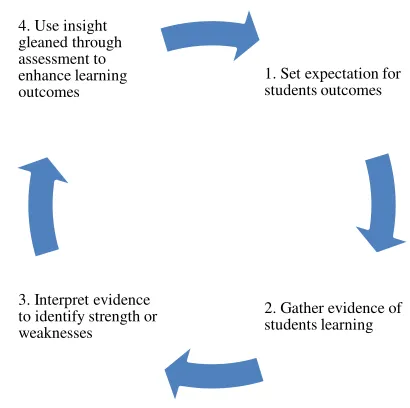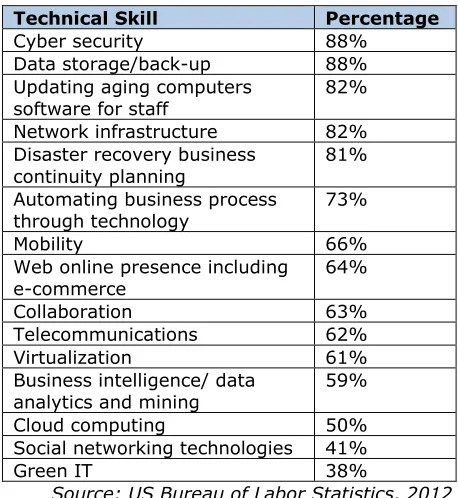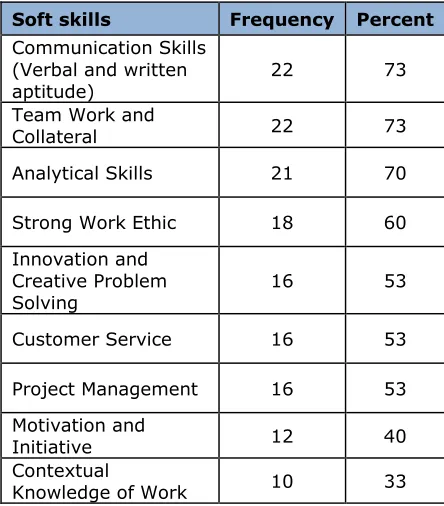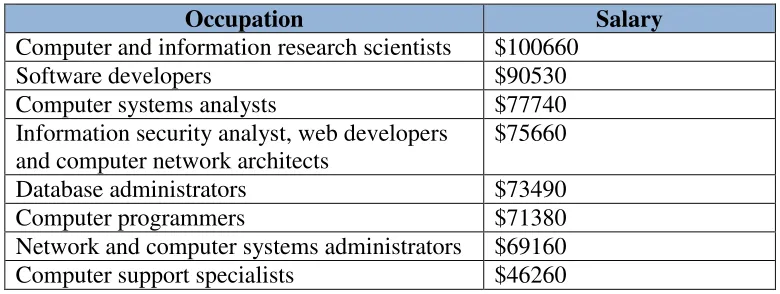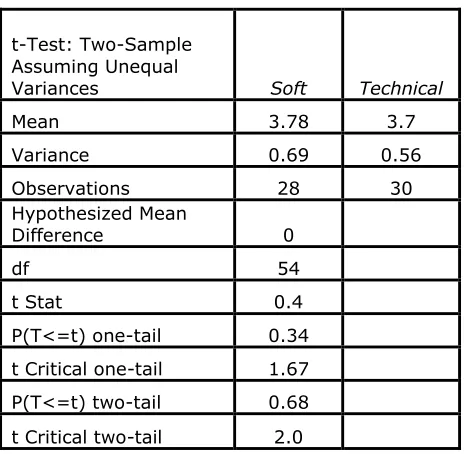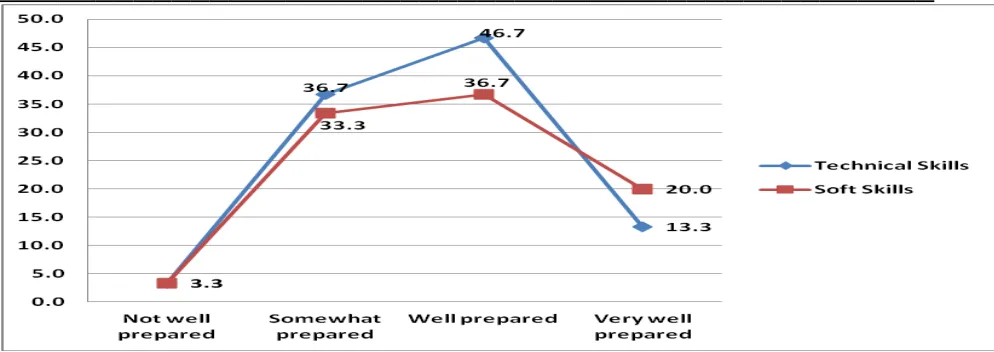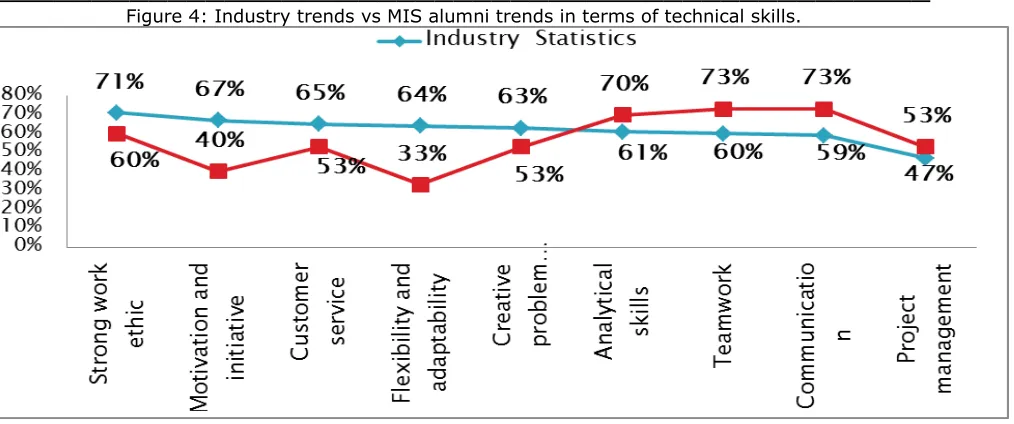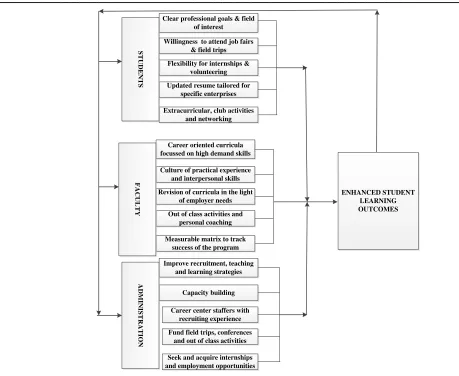_________________________________________________
_________________________________________________
Aligning Academic Curricula to Industrial Needs
Adnan Omar
aomar@suno.edu
Muhammed Miah
mmiah@suno.edu
Emmanuel Nkabyo
Emmnka5@yahoo.com
Southern University at New Orleans
New Orleans, LA 70126
ABSTRACT
Information technologies (IT) are developing rapidly and industry leaders depend on the educational system for a qualified workforce. Educators are tasked with the responsibility of designing curricula and practical activities that prepare students for the corporate world. Understanding today’s work requirements is essential in achieving this goal. This research investigates how well the Management Information System (MIS) program of a four year institution prepares its graduates for the requirements of the IT industry. Current industry data as well as survey analyses of the work experiences of the MIS alumni were used to identify how prepared they were. More than one-third, (36.7%) of the participants had positions related to managing information, and 3.3% were involved in software development, which has the highest job growth projection. From a list of technical skills, 6% of respondents were involved in cyber security which ranked highest, 88% in hiring priority of IT employers. The results serve as a baseline for improving student learning outcomes.
Keywords: Information systems, technical and soft skills, academic curricula.
1. INTRODUCTION
Post graduate student perceptions and their professional outcomes are important ways for evaluating and ameliorating an academic curriculum. A curriculum is a set of courses, content and sequence of experiences, offered at a University and it often contains a brief description of courses and the elements of teaching them (Ellis, 2004). A study from the Brookings Institution revealed a strong impact of
curriculum on students’ personal, social and
economic outcomes and emphasized the need for constant reassessment and improvement of curricula with regard to current changes in the business environment (Grover, 2009). In a recent study on higher education, Linda Klein
mentioned economic and professional progress as major reasons for enrollment in academic programs (Klein, 2012).
Each university designs its own curricula but its ability to produce desired outcomes varies and is subject to constant debate and research, since no curriculum is perfect, and its effectiveness
_________________________________________________
_________________________________________________
year institution with a focus on the skills and
requirements of today’s job market.
Aligning education to foster professional and workplace development is quite challenging in the field of information technology (IT). This is because the constantly changing IT landscape with advanced computer systems results in highly variable and transient job requirements (Davis & Woodward, 2007). The exponential development of new technologies is bringing new skills like cloud computing, system designers and application development skills to the forefront of the business environment. These new skills are redefining job descriptions today with more and more corporations needing IT services that were nonexistent some years back. In order for curricula to remain relevant, schools have to constantly reassess and redesign the in the context of the present corporate world.
Statement of the Problem
Performance of alumni in the workplace is a strong indicator of the strength and usefulness of the curriculum they experienced. The MIS curriculum of the institution is divided into four major course categories which include two primary courses, two communication courses, four management strategies courses and four technology infrastructure courses, with the last two categories making up its core competences. While the MIS program, like all other curricula, cannot by itself meet all the IT skills and job requirements of all employers, it is vital to investigate the effectiveness of the curriculum in helping students develop their core competencies and thrive in the workplace. In order to maintain or improve the strength of
the institution’s MIS program, it is important to
answer questions about the alumni ability to get a job expeditiously; the ability of the curriculum to help alumni handle the technical and non-technical skills on the job; their ability to get a job in an expeditious manner; the degree to which the curriculum affected their salary range; and how well any difficulties or weaknesses in the curriculum were addressed.
Statement of the Objectives
An effective evaluation of curriculum is vital to maintaining and improving standards. This research paper reassesses the MIS program by identify any possible causes. The research results will serve as a baseline for improving and redesigning the curriculum to meet real-world requirements.
2. REVIEW OF LITERATURE
Relationship between school and the workplace
There is a close association between education and employment. Regardless of the primary reason for pursuing studies, the notion that it is solely for personal satisfaction is unduly idealistic because the underlying motivation for pursuing studies continues to be the desire to be more competitive in the job market. Education has sometimes been the determining factor for finding a job, keeping a job, or climbing the ladder in a particular field of specialization. It is, therefore, true that preparing students for a future job is a valid university endeavor, and as such academia must tailor curricula to meet the
expectations of today’s work environment (Klein,
2012).
The role of higher education
_________________________________________________
context of today’s changing environment, more
can be achieved and should be expected of it. This is because a college degree of some sort is now a prerequisite to enter most professional fields, and so education systems ought to be shifting their focus toward providing students with useful abilities and talents in addition to simply knowing things. Curricula should be designed specifically to teach and prepare students for jobs (Fedder, 2012). Furthermore, studies also indicate that postgraduate qualifications are increasingly listed as job or promotion requirements in the corporate world, strengthening the job related purpose that is explicitly recognized in education (Chun, 2013). In between these two extremes are those who believe that while higher education, through a well-designed curriculum, can open prospects for jobs, it also depends on other aspects like the academic background and personal efforts of the students as well as the collaborative efforts between the schools and industries in terms of internships. This group suggests that curricula tend to be more effective for students with a similar academic background on admission into the program as compared to those without it. However, they affirm that academic curricula should include training which involves job experiences through internships within the industry (Teichler, 2007).
In her paper on learning outcome guidelines, Jennifer Lindholm argued that any successful academic program had to benefit from an ongoing process of inquiry and reflection that focused on growth, renewal, and continuous improvement. She discussed the outcome assessment feedback loop which focuses on gathering evidence that students can demonstrate proficiencies on the core competencies of the courses they take. Maintaining the flow and coherence within the loop requires combined efforts from the students, faculty and administration. This coherence is vital for the program to effectively enhance student learning outcomes (Lindholm, 2009). Educators can, therefore, acquire and
analyze data on the students’ performance and
use any relevant information to increase the quality of curricula. Figure 1 presents the outcome assessment feedback loop.
Figure 1: Outcome assessment feedback loop (Lindholm, 2009)
The outcome of education should be positive for the individual and society. Curricula should be designed to foster competences that are relevant for successful professional practices (Smith, 1996). This is even more important for the IT sector which has experienced considerable changes in recent years. IT educators must therefore have updated information about the changing trends and projections in the IT world in order to adapt curricula to the emergence of new knowledge and the present context of the IT job market.
IT Labor Market Statistics and projections
Since 2010 there has been strong employment outlook in the information and communication technology (ICT) sector. The US Bureau of Labor Statistics now predicts an increase of 22% in employment for all computer related occupations from 2010 through 2020 as compared to a 14% increase in all other occupations (US Bureau of Labor Statistics Occupational Outlook Handbook, 2012)
_________________________________________________
_________________________________________________
Table 1: Percentage growth of IT Occupations through 2020
Occupational Categories Percentage
Software developers, systems 32% Database administrators 31%
Computer systems analysts 22% Computer and information
research scientists
19% Computer support specialists 18% Computer programmers 13%
Source: US Bureau of Labor Statistics, 2012
Recent studies also revealed a high demand for IT technical and non-technical skills. Table 2, obtained during a survey of 353 IT executives, presents technical skills ranked in order of hiring percentage for 2012.
Table 2: IT Technical Skills in order of hiring percentage for 2012 Network infrastructure 82% Disaster recovery business
Social networking technologies 41%
Green IT 38%
Source: US Bureau of Labor Statistics, 2012
The same research provided additional insight
on the “soft skills” needed in the IT professions.
This data is represented in Table 3.
Table 3: Non-technical “Soft” Skills in order of hiring percentage for 2012
Soft Skill Percentage
Strong work ethic 71%
Motivation and initiative 67%
Customer service 65%
Flexibility and adaptability 64% Innovation and creative
problem solving
63%
Analytical skills 61%
Teamwork 60% projected growth through 2020. Such indicators enable educators to design curricula that ensure the development of these skills and meet real
In view of these changing trends and projections in the IT industry, academic institutions are reassessing curricula in order to adapt them to the requirements of today. In a recent study carried out at Southern Illinois University, survey questions related to post graduate experiences as well as the Information System curriculum were sent to the university graduates who had gone through a four year undergraduate curriculum. The results showed that almost 85% of the graduates were employed within six months of graduation. Concerning their primary functions in the information systems jobs, the top was networking with 24.6% of respondents while e-commerce had no respondent in that occupation. In terms of tasks performed, the greatest number of graduates provided technical and end-user support with a frequency of 33%. To the question of how well the information systems curriculum prepared them for their job, the graduates responded with a mean of 3.5/5 (Legier et al., 2012).
_________________________________________________
_________________________________________________
The purpose of this research is to investigate the strengths and/or weaknesses of the MIS program of a four year institution using data on the experiences of a sample of its alumni presently in the workforce. Specifically, it identifies the types of technical and non-year institution using its Management Information Systems (MIS) graduate program for the investigation. The institution’s College of Business and Administration (CBA) provides students with high quality information systems education through the MIS program. The program, which has a diverse demographic and ethnic representation, was started in 1998 and aims at giving students a foundation in the dual functional areas of business and information technologies and enabling graduates of the program to pursue a career in both technical and management areas in public or private organizations.
The MIS curriculum offers a 120 credit hour undergraduate curriculum and a 39 credit hour graduate curriculum which prepares students for analysis, design, development, implementation and management of real world computer based systems. In a bid to maintain and improve standards, this research study used data collected from a sample of the program’s alumni to reassess how effective the MIS program is in preparing its graduates for the skills required by employers in the IT industry.
Research Design
To carry out this study a quantitative research analysis method was used in which a number of participants were asked a standard set of questions through a survey. Questions were the same for all participants with a standard range of answers for 10 out of the 11 questions and the last having a comment field for suggestions. The findings were represented as numerical data and interpreted using statistical concepts. The results were compared with secondary data on the educational background of the students to identify any possible causes of inefficiency in the program.
This research was designed as a baseline study for improving the MIS program. It uses the outcome assessment feedback loop approach (Figure 1) to produce a dynamic model that can be updated annually and used to increase the quality of the program. This approach focuses on the extent to which students completing the program can demonstrate proficiencies in the
program’s core competences (Lindholm, 2009).
Survey questions
1- When did you get your first information systems technology related job?
2- What was the primary focus of your information systems technology job? 3- What type of task do you regularly
perform in your job?
4- How well did the MIS curriculum prepare you for your job?
5- What are the non-technical (soft) IT skills critical in your job?
6- How well did the MIS curriculum prepare you for these "soft skills"?
7- Annual entry-level salary range of your information systems technology job? 8- Please indicate your gender.
9- Please indicate your ethnicity.
10-Please indicate your last degree program at the institution.
11-Please provide any suggestions/ comments on how to improve the program chairperson collected the email addresses of the graduates from the student service unit and sent the survey to the alumni via email. The emails included the purpose of the study as well as the survey questionnaires. The participants completed the survey and returned it to the chairperson via email. A reminder was sent by the chairperson two weeks later to ensure responses from a maximum number of participants; of 40 students contacted, 30 responded, giving a 75 percentage response. The chairperson numbered the responses and sent them for analyses.
Statement of the Hypothesis
The impact of curriculum on the student’s
_________________________________________________
_________________________________________________
curricula tend to be more effective for students who had an IT background upon admission as compared to those who did not. In the context of the four year institution with a majority of the students in the MIS program coming from non-IT majors, this could be an aspect to consider in the learning outcomes of the program. This research tests the following assumptions:
H1: The curriculum enhanced the job
performance of the students.
H2: The curriculum gave the students skills that
have high market value in today's IT industry.
H3: The academic background of the students
affected their learning outcomes.
Hypothesis 1 will be tested using specific data on
the graduates’ work experience as well as
perceptions on their level of preparedness for these tasks. The technical and non-technical tasks performed as well as elements like job focus will be compared with the trends in today’s IT industry to verify hypothesis 2. The survey results and the academic background of the students will be analyzed to determine if it played a role in the students’ learning outcomes to verify Hypothesis 3.
Data Analyses
The survey used the Likert scale to collect data for some of the questions. Data analysis was accomplished by using the arithmetic mean to measure the central tendency of the respondents. Data collected by the program chair from the student service unit of the institution were used to examine the academic background of the participants. SPSS statistics 20.0 and Microsoft Excel 2010 software were technical and soft skill preparation as well as the
relationship between students’ backgrounds and
their performance.
4. FINDINGS
Demographics
The research participants included 17 males (57%) and 13 females (43%). Question 9 studied the ethnicity of the 30 respondents with 21 of the respondents identified as black African/ American (70%), 2 as white (6.7%), 4 as Asian (13.3%) and 3 as other (10%).
Time taken to find first job
The time taken to find a job was asked in question 1 to assess the employment history of the participant and also have an insight into their competitiveness in the job market. All the participants responded with 40% saying they were employed prior to graduation, 6% indicating they had an offer prior to graduation, 20% stating they found a job in less than three months, 17% saying they found a job in more than three months and less than six months, and 17% indicating they were employed after 6 months.
The percentage employed prior to graduation indicates that the program had many nontraditional students who were either fully or partially employed while enrolled in the program. The numbers for those who had an offer or were employed less than 3 months after graduation shows that about 25% of the sample were employed relatively quickly and can be indicative of a high market value for this group. However it is worth mentioning here that with a significant percentage of non-resident foreigners in the program, other factors like visa status could influence the length of time taken to find a job.
Salary
Twenty-eight of the respondents provided answers to question 7 which focused on the entry-level salary range of their first information systems job. Of this number, 36.7% indicated they earned less than $40,000, 33.3% said they earned between $40,000 and $50,000 and 23.3% of the graduates made more than $50,000.
Job focus
In question 2 participants were asked to choose their primary job focus from a list of nine primary IT job categories. Each respondent was only allowed to pick one primary job focus. Thirty-six percent (36%) of the respondents identified information management as their job focus. Approximately 14% chose project management. Table 5 provides a complete breakdown of responses to this question by number and percent.
Technical skills
_________________________________________________
Table 5: Primary Job focus of alumni
Job Focus Frequency Percent
Information
The non-technical soft skills performed by participants were studied in question 5. They were asked to choose from a list of 9 categories. The respondents could pick all that applied and 30 participants completed the question. The most frequently picked were communication (verbal and written) and team work with 22 participants choosing them. The second was analytical skills with 21 participants, while contextual knowledge was least with 10 participants picking it. Table 7 provides the complete breakdown of the responses.
Level of preparedness
Questions 4 and 6 addressed the issue of how
well the graduates felt the institution’s MIS
program prepared them for the technical and non-technical tasks performed at their jobs. All participants answered question 4 while 28 responded to question 6. T-test analyses of the answers in Table 8 (see Appendix) showed a mean of 3.78 for soft skills and 3.7 for technical skills.
The research findings were further expanded and analyzed using secondary data obtained in the literature review to study key issues used to verify the hypothesis, and to identify any causal effects and propose recommendations.
A mean of 3.7/5, representing the graduates’ perception of their technical and soft skill preparation, shows that a majority indicated that the program prepared them and enhanced their professional learning outcomes; thus, H1 is
accepted. A cross representation of the distribution between the level of preparation for technical and soft skill requirements shows that more participants felt very well prepared for the soft skills as compared to technical skills. Figure 2 (see Appendix) shows a representation of the two variables.
Table 7: Soft skills performed by graduates
A comparison of the primary job focus of the participants with the trends and projections of IT occupations through 2020 shows to what extent these graduates are involved in high demand jobs as well as the competitiveness of the graduates. Among the eight major IT occupations obtained from the US Bureau of Labor Statistics (see Table 1), the occupation with the highest projected growth is system and software developers with 32%; contrasting this value with data obtained from this research shows that the current level of involvement of the sample studied was the lowest, 3.3% in this occupation. Database administrators with growth projections of 31% had 6.7% of the graduates in this field as shown in Figure 3 (see Appendix). Comparing the technical and soft skills performed by the alumni to industry data (See
Soft skills Frequency Percent
Communication Skills
Project Management 16 53
Motivation and
Initiative 12 40
Contextual
_________________________________________________
_________________________________________________
Tables 2 and 3) shows that 6% of the sample studied were currently involved with skills related to cyber security which ranked highest in hiring percentage for IT managers. Cloud computing, which had 50% hiring rate for IT managers, had no participant involved with skills related to this area. Figure 4 (see Appendix) presents the trends in terms of technical skills. Results showed better trends for soft skills with 60% of the sample studied indicating that highly valued skills like a strong work ethic were critical to their current jobs. Teamwork, another soft skill critical to IT managers also had a majority of participants (73%) involved in it. Figure 5 (see Appendix) shows the trends in terms of soft skills.
Figures 3 and 4 show significant differences between the trends of the MIS alumni and those of the industry in terms of job focus and
Background information of the respondents revealed that 80% of these participants had non-IT majors on admission. Research results showed that 60% of the participants believed the curriculum prepared them for the skills required in their jobs, an indication that some of those with non-IT backgrounds were part of this group. This means that the curriculum was effective even for students with non-IT backgrounds. Moreover the Wilcoxon test showed a p value of 0.5, indicating that there was no significant relationship between the academic background and performance of the participants. H3 is, therefore, rejected in this
research. Table 9 (see Appendix) shows results of the correlation analyses between academic background and performance. program. Enhancing student learning outcomes and preparing them for the workplace requires a holistic approach involving contributions from students, faculty and the administration. In order to constantly improve the MIS program in light of the industry requirements, the
assessment feedback loop must be applied
yearly to get feedback about the students’
practical experience (See Figure 1).
Extracurricular value-added activities that add to
the students’ educational experience are
necessary to ensure that graduates of MIS programs stand a better chance of excelling in the job market.
The institution’s College of Business and
Administration (CBA) has carried out some of these value-added initiatives in recent years. Career oriented events have been organized by a number of organizations within the college. These associations include the Black Executive Exchange Program (BEEP), the Public Administration Association, the National Black MBA Association and the Management Information Systems (MIS) club. These associations not only brought speakers with extensive business and technical experience to talk to and answer questions from students and faculty, but also brought renowned business and governmental organizations like General Electric (GE), McDonalds, and Waffle House.
The CBA has also introduced award ceremonies for graduating seniors as well as the Sigma Beta Delta induction ceremony which rewards academic excellence. In light of the dynamic changes in technology, the MIS department also undertakes a review of its curriculum every year to improve the quality of its program, an effort that contributed to the CBA obtaining AACSB International accreditation, another significant value-added accomplishment that will enhance the competitiveness of its graduates in the job proposed model for achieving this goal.
Proposed model
Alongside the successful completion of all the academic requirements and coursework during the MIS program, students must carry out other extracurricular activities like keeping a clear list of personal and professional goals which specify
_________________________________________________
_________________________________________________
Faculty, on the other hand, must design and implement career oriented curricula. Analytical and project management applications that are critical today would be helpful as well as software programming languages that are currently in high demand like java, .net and mobile development applications. Faculty should ensure that students understand how the knowledge acquired in the school program translates into real world applications in the workplace. The classroom experience should also promote entrepreneurial initiatives and technological innovation and should incorporate interpersonal skills. The curriculum must be regularly revised in the light of employer needs and the current dynamics of the professional environment.
To enhance institutional readiness, the administration should continuously improve its recruitment, teaching and learning strategies in line with their collegiate and institutional objectives. Policies that ensure partial or full funding of events like field trips and conferences will increase the participation of students and improve their learning outcomes. The administration should undertake a more aggressive strategy for employment opportunities.
6. CONCLUSION
Information technologies will continue to evolve in the coming decade, and so will the job requirements of the industry. This study reassessed the MIS program of a four year institution by using the workplace experience of its alumni to identify how well the program
prepared them for today’s IT requirements.
Results showed that 73% of respondents were involved in critical soft skills and only 6% in highly valued technical skills like cyber security. This indicates that more has to be done to give the students highly valued technical skills that meet industry expectations and projections. Results also showed that the academic background of the participants did not play a major role in the outcome, indicating that an effective curriculum, tailored according to the IT requirements of today, can give students the best possible preparation for the job market regardless of their background. This further underlines the importance of constant research on developments in the industry to improve expectations range from social satisfaction to financial and professional progress, and are emphasized in every investment that students, educators and stakeholders put into academics. Consequently, it is vital that all stakeholders play their role to ensure that academic programs give the students the adequate potential to
thrive in today’s technological environment. 7. REFERENCES
CompTIA. (2012). State of the IT skills gap research report. CompTIA.org. Retrieved
March 27, 2013, from
http://www.wired.com/wiredenterprise/wp-
content/uploads//2012/03/Report_-_CompTIA_IT_Skills_Gap_study
Chun, J. (2013). Should you do postgraduate study? Course Finder. Retrieved January 31,
2013, from
http://www.careerfaqs.com.au/news/news- and-views/should-you-do-postgraduate-study
Davis, D. C. & Woodward, B. (2007). An analysis of skills required of graduates of an information systems program. Information Technology, Learning, and Performance Journal, 2(24).
Ellis, A. (2004). Exemplars of curriculum theory. Larchmant, NY: Eye on education, p.4 . Fedder, J. (2012). Has the university lost its
purpose for preparing its students for the future? TED Conversations. Retrieved
January 31, 2013, from education serve? Beta echoing green. Retrieved February, 27, 2013, from
http://www.echoinggreen.org/blog/what-purpose-does-higher-education-serve
_________________________________________________
_________________________________________________
of an information systems program. Education special interest group of the AITP. Lindholm, J. (2009). Guidelines for developing
and assessing students learning outcomes for undergraduate majors. 1 Edition. Los Angeles, Ca: UCLA.
Patin, R. (2012). Has the university lost its purpose for preparing its students for the future? TED Conversations. Retrieved
January 31, 2013, from
http://www.ted.com/conversations/9392/ha
s_the_university_lost_it_s_p_3.html
Smith, S. (1996). Establishing or re-establishing a connection between education and the workplace. Canada-United States Law Journal, 22241.
Teichler, U. (2007). Does higher education matter? Lessons from a comparative graduate survey. European Journal of Education, 42 (1), 11-34.
_________________________________________________
_________________________________________________
APPENDIX
Table 4: IT occupations and median salaries
Occupation
Salary
Computer and information research scientists
$100660
Software developers
$90530
Computer systems analysts
$77740
Information security analyst, web developers
and computer network architects
$75660
Database administrators
$73490
Computer programmers
$71380
Network and computer systems administrators
$69160
Computer support specialists
$46260
Source: US Bureau of labor statistics occupational outlook handbook, 2012
Table 6: Task performed by graduates
Task Performed Frequency Percent
Managing Information 19 63
Automating business Processes (Managing Accounts, customization) 16 52
Maintaining Databases 11 33
Web presence (Creating/ monitoring Web pages, Developing e-commerce apps)
10 32
Providing technical/end user support 9 30
Other type of task perform regularly at your job 9 30
Virtualization (Analyzing systems/ Developing and redesigning systems) 8 26
Installing Software 7 23
Networks (Maintaining/ trouble shooting networks, Setting up LANs) 7 23
Installing/Maintaining Computer Devices 4 13
Writing Computer programs 4 13
Monitoring online security Systems 2 6
_________________________________________________
_________________________________________________
Table 8: t-Test for technical and soft skills
t-Test: Two-Sample Assuming Unequal
Variances Soft Technical
Mean 3.78 3.7
Variance 0.69 0.56
Observations 28 30
Hypothesized Mean
Difference 0
df 54
t Stat 0.4
P(T<=t) one-tail 0.34 t Critical one-tail 1.67 P(T<=t) two-tail 0.68 t Critical two-tail 2.0
Table 9: Wilcoxon Test for academic background and performance of graduates Wilcoxon Two-Sample Test
Statistic (S) 22.5000
Normal Approximation
Z 0.0000
One-Sided Pr < Z 0.5000
Two-Sided Pr > |Z| 1.0000 t Approximation
One-Sided Pr < Z 0.5000
Two-Sided Pr > |Z| 1.0000 Exact Test
One-Sided Pr <= S 0.5275
Two-Sided Pr >= |S - Mean|
_________________________________________________
_________________________________________________
Figure 2: Level of preparedness of MIS alumni for technical and soft skills
_________________________________________________
_________________________________________________
Figure 4: Industry trends vs MIS alumni trends in terms of technical skills.
_________________________________________________
_________________________________________________
Clear professional goals & field of interest
Willingness to attend job fairs & field trips
Flexibility for internships & volunteering
Updated resume tailored for specific enterprises
Extracurricular, club activities and networking
Career oriented curricula focussed on high demand skills
Culture of practical experience and interpersonal skills
Revision of curricula in the light of employer needs
Out of class activities and personal coaching
Measurable matrix to track success of the program
Improve recruitment, teaching and learning strategies
Capacity building
Career center staffers with recruiting experience
Fund field trips, conferences and out of class activities
Seek and acquire internships and employment opportunities
S
TU
D
EN
TS
ENHANCED STUDENT LEARNING OUTCOMES
F
A
C
U
LTY
A
D
M
IN
IS
TR
A
TI
O
N
